Zotac ZBOX EI750 Plus: A Feature-Rich Iris Pro mini-PC
by Ganesh T S on August 25, 2014 7:00 AM ESTPerformance Metrics - II
In this section, we mainly look at benchmark modes in programs used on a day-to-day basis, i.e, application performance and not synthetic workloads.
x264 Benchmark
First off, we have some video encoding benchmarks courtesy of x264 HD Benchmark v5.0.

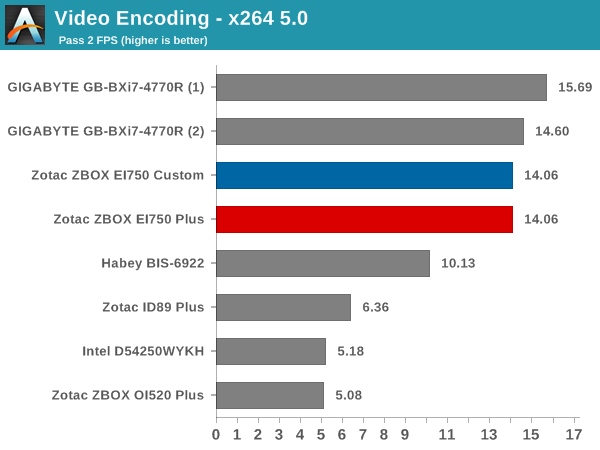
7-Zip
7-Zip is a very effective and efficient compression program, often beating out OpenCL accelerated commercial programs in benchmarks even while using just the CPU power. 7-Zip has a benchmarking program that provides tons of details regarding the underlying CPU's efficiency. In this subsection, we are interested in the compression and decompression MIPS ratings when utilizing all the available threads.
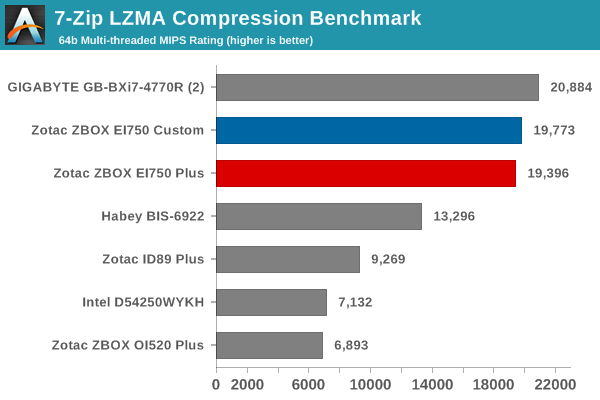
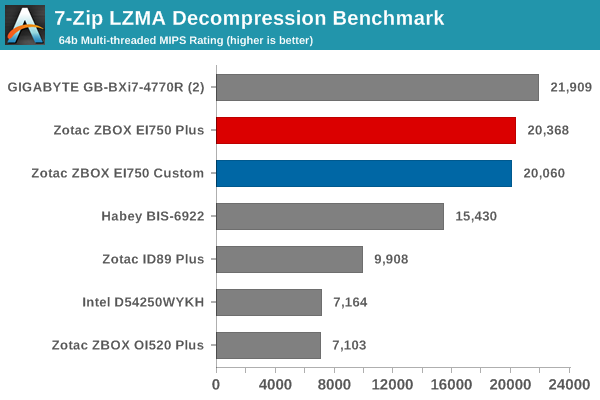
TrueCrypt
As businesses (and even home consumers) become more security conscious, the importance of encryption can't be overstated. CPUs supporting the AES-NI instruction for accelerating the encryption and decryption processes have, till now, been the higher end SKUs. However, with Bay Trail, even the lowly Atom series has gained support for AES-NI. The i7-4770R, being the flagship Crystal Well part for Haswell, hasn't been left behind. It does have AES-NI support and TrueCrypt, a popular open-source disk encryption program which can take advantage of the AES-NI capabilities. The TrueCrypt internal benchmark provides some interesting cryptography-related numbers to ponder. In the graph below, we can get an idea of how fast a TrueCrypt volume would behave in the ZBOX EI750 and how it would compare with other select PCs. This is a purely CPU feature / clock speed based test.
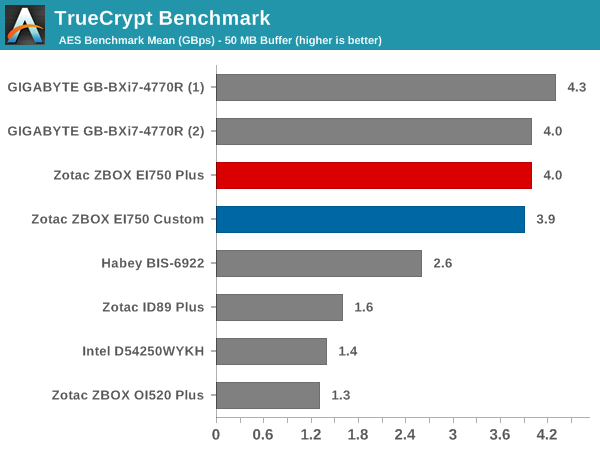
Agisoft Photoscan
Agisoft PhotoScan is a commercial program that converts 2D images into 3D point maps, meshes and textures. The program designers sent us a command line version in order to evaluate the efficiency of various systems that go under our review scanner. The command line version has two benchmark modes, one using the CPU and the other using both the CPU and GPU (via OpenCL). The benchmark takes around 50 photographs and does four stages of computation:
- Stage 1: Align Photographs
- Stage 2: Build Point Cloud (capable of OpenCL acceleration)
- Stage 3: Build Mesh
- Stage 4: Build Textures
We record the time taken for each stage. Since various elements of the software are single threaded, others multithreaded, and some use GPUs, it is interesting to record the effects of CPU generations, speeds, number of cores, DRAM parameters and the GPU using this software.
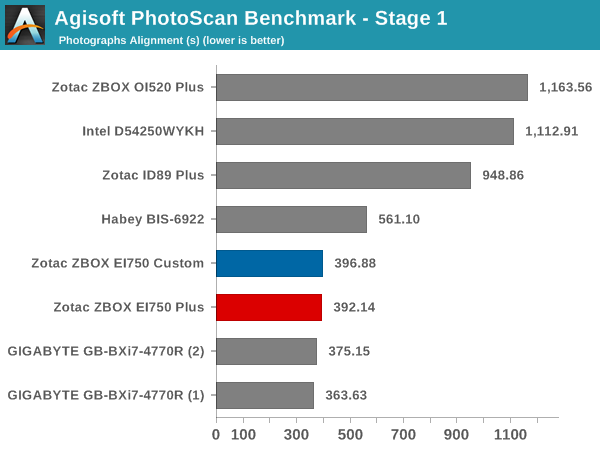
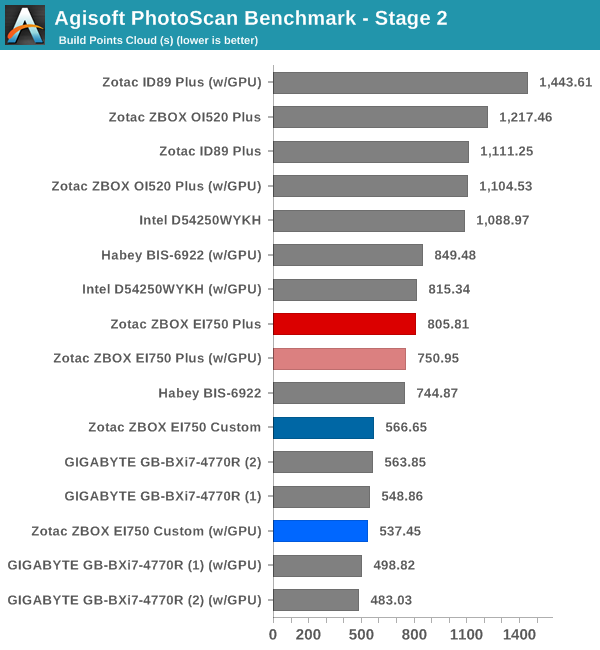
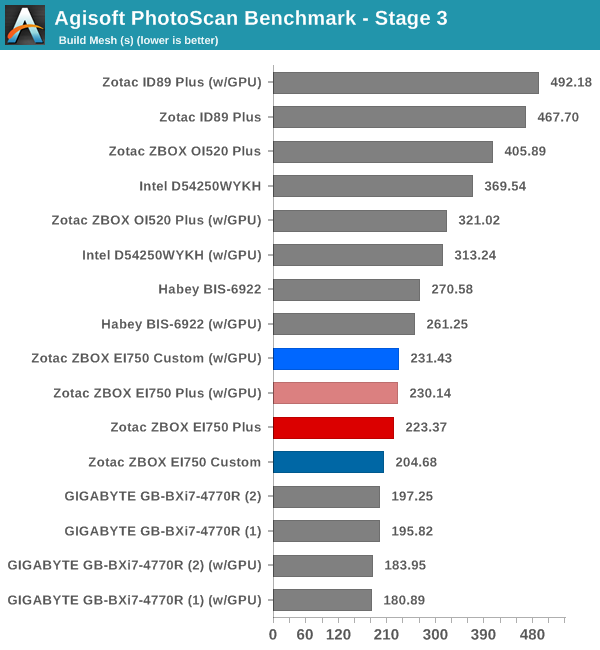
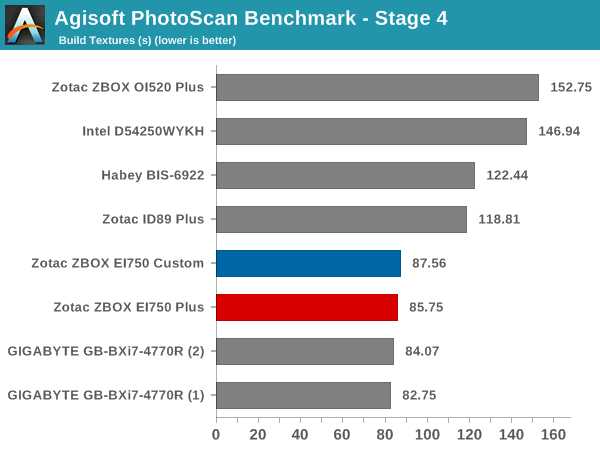
Dolphin Emulator
Wrapping up our application benchmark numbers is the Dolphin Emulator benchmark mode results.
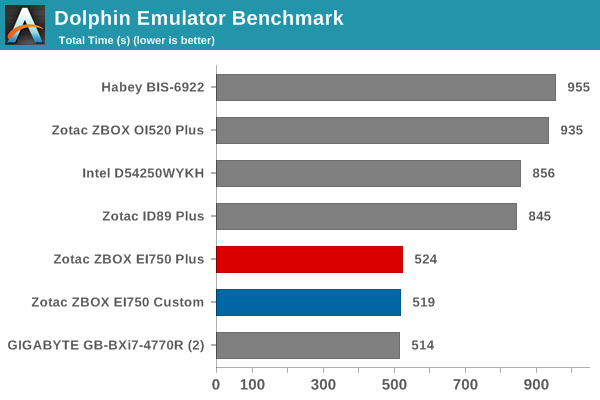










34 Comments
View All Comments
xdrol - Monday, August 25, 2014 - link
"EPIC GAMING" is also on the box..fokka - Monday, August 25, 2014 - link
any idea why the brix pro manages to get considerably higher fps, albeit using the same iGPU?NARC4457 - Monday, August 25, 2014 - link
just a quick comment from a BI standpoint - I think it would be a better presentation to flip your ranking for charts where "lower numbers are better". Having the "1st Place" ranking at the bottom of the chart is opposite from the rest of the charts. Having it at the top presents a consistent message.Regarding the content, all measurments show the Brix to be a better performer (aside from wifi) with extra throttling. I don't see the point of having an i7 box that cannot run at full tilt.
rituraj - Monday, August 25, 2014 - link
Exactly my thoughtsjwcalla - Monday, August 25, 2014 - link
Before I clicked the article link I asked myself, "How much you want to bet this thing is ridiculously expensive?"Check!
yannigr2 - Monday, August 25, 2014 - link
It's difficult to read the graphs without the information about the gpu(gaming benchmarks) or the cpu(performance metrics) near the name of each machine. You just can't remember each machine's specs. So you just scroll down fast and don't really read them which is really a pity considering the work that is done in this article.leopard_jumps - Monday, August 25, 2014 - link
A rig with FX 6300 and GTX 660 wiil outperform that and the price will be lower .Shiitaki - Monday, August 25, 2014 - link
The thing Intel won't accept is that their graphics is substandard, and inferior. And yet they insist on combining the best graphics capabilities on to the most expensive cpus. The very cpus, which are the most likely to NOT use the integrated graphics.The Iris graphics is great, on a dual core! Not a quad core, and certainly not on a hyper threaded quad core! Intel like Microsoft concentrates too much on forcing everyone to buy the product they want to sell, not selling the products people want to buy.
bsd228 - Tuesday, August 26, 2014 - link
no one is buying discrete graphics for a mini system like this. You do want the best graphics (focused on video playback) that you can get, but you're not going to change the size profile, nor do you want a hot AMD chip with lower cpu performance either. The gamers...they are getting something different.Laststop311 - Monday, August 25, 2014 - link
This thing would make a ROCKIN htpc. I would have to add a ram stick to make it dual channel and I would want at least a 256GB samsung evo msata for the OS and games and applications, maybe even 512GB considering how large games can be and the fact the standard hdd won't be used. The spinning hard drive can go, much better to have a nas store the massive movie catalog you acquire for watching on the tv. Get an xbox one controller with the windows drivers up and running on it and install emulators for all the older games have full catalogs for mame, atari, nes, snes, genesis, neo geo, gameboy, game gear, nintendo ds, ps1, nintendo 64, psp.Sure you will end up spending like 1200 dollars when all is said and done on just an HTPC. But this isn't your average HTPC. It's incredibly small and quiet and power efficient and it's the ultimate freakin entertainment hub. And the 1200 pays for itself when you get infinite movies and music albums for free that alone pays itself off. Instead of paying 15-20 per movie and 10 per album all those savings adds up to getting the htpc for free essentially. That's not even counting having a huge full catalog of every retro gaming system at your fingertips to play on your tv as well and with xbox one controllers you don't have to be stuck with bad controls for the old games. Hook up a wireless keyboard and mouse as well and you got great couch surfing abilities as well like that old school webtv device that let you browse the web from the couch.
I could see myself replacing my extremely ghetto full tower htpc that is just an old regular pc repurposed as a htpc. It's a core 2 duo x6800 running at 3.61ghz which when I originally got it 8 years ago was pretty speedy and the gpu it currently has is a little more recent a radeon 4870. I wonder if the iris pro 5200 can beat the dedicated radeon 4870.
I probably won't though. The main issue with this is the broadwell version of these mini pc's is supposed to be hitting stores q1 2015. Secondary issue is replacing my x58 core i7-980x to x99 core i7-5960x is my main priority. I will likely wait and see how the i7-5770r stacks up. Intel always makes a rly nice push on the graphics side when they shrink during a tock. All the extra transistors available allows them to really pump up the integrated gpu. Crystal well's successor should basically make dedicated gpu's totally extinct in htpc's.